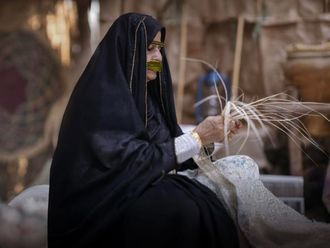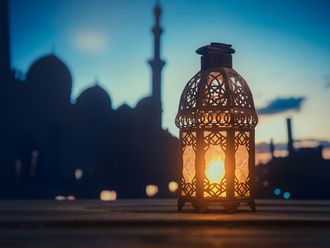Sudhir Vyas has written a number of articles on issues related to birds in the prestigious Bombay Natural History Society's journal. ©Gulf News |
Indian diplomats have been in the news recently for penning novels. It's not rare to find diplomats pursuing a passion far from real politik. Sudhir Vyas, Indian ambassador to the UAE, is no different.
An avid ornithologist, he has more than a bird's eye view of this field. He can easily rattle off the name of an exotic and dramatically multi-hued tailed bird in Indonesia by a mere description.
Waxes eloquent on the evolutionary history of the birds in Madagascar and on how nature has cleverly camouflaged the desert birds in pale, sandy colours to protect them. Or the play of nature in making the song of the desert lark — roaming the relatively empty landscape of sands — a muted trill, while the sounds of the rain forest parrot are more of a loud shriek so as to be heard in the lush avian environment.
It seems gauche to badger this seasoned and senior ornithologist with questions on his favourite bird in the universe or his most rare sighting.
Or where in the world is a haven for a bird watcher? The questions may seem trite for the 50-year-old Indian Institute of Technology alumnus, who's been a twitcher from his school days and is at a stage where his current focus of interest is in studying the evolutionary history of birds.
If you search through the Internet, you can come across Sudhir Vyas in discussions among e-groups such as Indiabirds.com, birdsofbombay, delhibird/ northern India bird network, conversing on the sighting of the striated grassbird in Okhla or whether the war in Afghanistan had an adverse effect on the migration of cranes and where can you sight birds in a certain area.
This bird lover has, in fact, written a number of articles on issues related to birds in the prestigious Bombay Natural History Society's journal and has spent time studying the bird life of India's capital New Delhi and the Indo-Gangetic plain as well as around Pune and Visakhapatnam and parts of the Himalayas from Nepal up to Bhutan.
Moreover, as most veteran bird watchers, he has acquired the skill of recognising birds by their calls or by a dab of colour on their tail. Thus, to a reply on his "special moment" during his decades of bird watching, Vyas in a I'm-not-wearing-the-diplomat-but-birder-hat interview with Tabloid, says, "There are a thousand special, imaginative moments while birding."
Revealing a poetic streak, Vyas narrates, "Walking by the Yamuna river in New Delhi and spotting 15,000 geese taking off from the water simultaneously is a stupendous moment; or standing somewhere in the Nepal mountains at sunset and watching snow-white egrets against snowy peaks as they turn pink in the sunset. Or enjoying the wealth of wildlife in East African parks or spotting a Malabar trogon in a beam of sunshine after the rains abate in Visakhapatnam in India. What can I tell you?"
Or Vyas, who was once posted in the permanent mission of India at the UN in New York, recalls the "image of hundreds of birds" flocking to the "wooded" Central Park in the centre of a concrete jungle during spring migration.
A passion
Truly, it's another world out there for birders. These feathered creatures, their bright, lively colours, movements, behaviour or migration patterns could become an all-consuming passion.
Bird lovers have mushroomed all over India today, says Vyas. "In the 1960s, when I started out it would be difficult to find a single birding companion but today there's a host of them from different professions," he admits.
The reasons for the surge in the affinity towards birds, Vyas believes, are because of the various television channels that deal with environment, focus on environmental issues in school curricula and a tendency to compensate for the loss of nature in urbanised settings and interacting with nature.
The attraction towards these feathered friends of nature for Vyas is cerebral as well as a source of pure, unadulterated joy. Relates Vyas, "I could tell you all the standard things on why I'm into bird watching. That it teaches you humility before the grandeur of nature or it makes you interested in behavioural sciences. How natural patterns evolve, why certain species occur in certain places, the nesting patterns and the evolution. All this may be true but for me, it's also a love for the outdoors, the freedom and the sense of space, and a form of relaxation."
As an ornithologist, the Indian Ambassador, who joined the Indian Foreign Service in 1977, did the bulk of his bird sightings had honed his skills during his college days in IIT, Kanpur, and in New Delhi, he reveals.
However, even today as a diplomat, he's active in the birding circles being a life member of the premier natural history group in India, the BNHS, and the London-based Oriental Bird Club and joins the local wildlife organisations in the many countries he's been posted.
Thus, he's familiar with the birds of Northern Africa having spent time with them during his diplomatic assignments in Egypt and Algeria, the North American avifauna birds during his UN tenure in New York and knows about Himalayan bird life because of a posting in Nepal and travels in Bhutan.
But Vyas has largely focused on bird life of New Delhi area and has published articles in the BNHS magazine on this issue. "The evolution of Delhi's bird life has been parallel to the growth of the city. The study of the bird life in this city seems to have occured in phases with 10-year gaps from New Delhi's creation in the 1920s and in the 1980s and 1990s, I had contributed my mite to the study."
Delhi is truly a birder's paradise, he says, because it lies on the edge of the two distinct habitats. It has deserts to the west, the Gangetic wetlands to the east and with the Himalayas not far away, it forms an interesting mix of bird life. It's an exceptional place to study bird migration in north India, lying as it does along the Jamuna river's migration route.
His passion for birds is further underscored by a letter on one of the e-groups on the Internet which he's written to a fellow twitcher. "It is worth noting that migratory Peregrines (calidus) do appear occasionally over urban Delhi. I know of one that appeared in 1997-98 winter over Connaught Place, perching on one of the tall buildings on Kasturba Gandhi Road and hunting over the central park. But the best urban Peregrine watching I have had was from my 11th floor office window during a stint in Dar-es-Salaam, Tanzania — one had its favourite perch just off my balcony and it spent hours hanging and swinging in the sea breeze, offering wonderful distraction from work."
How does he reconcile his busy life as a diplomat with birding? "It takes my mind of work. And, I manage to fit in my passion in the early mornings. I make time












